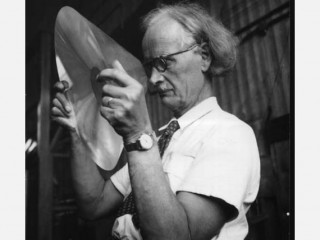
Auguste Piccard biography
Date of birth : 1884-01-28
Date of death : 1962-03-24
Birthplace : Basel, Switzerland
Nationality : Swedish
Category : Science and Technology
Last modified : 2010-12-29
Credited as : Scientist, physicist and explorer, measure cosmic rays
The Swiss scientist Auguste Piccard is famed for his explorations of the stratosphere and the ocean depths.
Born into an academic family in Basel on Jan. 28, 1884, Auguste Piccard was educated there and at the Zurich Polytechnic. From 1907 he taught in Zurich, was early interested in aviation, and studied the behavior of balloons. In 1922 he went to Brussels University as professor of physics, where he remained until 1954 (except during the war years, which he spent in Switzerland). He wished to investigate the physics of the stratosphere, a region which was beyond the range of sensitive automatic instruments until the advent of electronics and continuous radio monitoring from the ground. Supported by the Belgian Fonds National de la Recherche Scientifique, in 1930 Piccard designed a hydrogen balloon supporting an airtight cabin to carry an observer into the stratosphere. With this balloon (named FNRS) in 1931-1932 he reached record heights of over 50, 000 feet. Thus was a new era of scientific exploration opened. Lack of funds prevented his participation in further flights.
In 1937 Piccard turned to deep-sea exploration and developed the bathyscaphe, the underwater analog of his stratosphere balloon. Aided again by the Belgian foundation, work began but was interrupted by war. Thus the first bathyscaphe, FNRS 2, was not completed until 1948. It consisted of a strong spherical cast-steel capsule with Plexiglas windows supported by a lightly constructed float filled with petroleum. As in an air balloon, vertical movement was controlled by the release of ballast or supporting fluid. In the bathyscaphe iron-shot ballast was retained by energized electromagnets and released by interrupting the current. Dives off Dakar in 1948 proved the utility of the system.
In 1950 the vessel was transferred to the French navy and a new bathyscaphe, FNRS 3, was constructed. Initially under the direction of Piccard, it utilized the pressure capsule and much essential equipment from the FNRS 2. But difficulties with the French and contacts made in Italy by Piccard's son, Jacques, led to their building a third bathyscaphe, the Trieste, with Swiss and Italian funds in 1952-1953. Essentially similar to the FNRS vessels, the new bathyscaphe had many improvements, including a forged-steel capsule. A successful dive of more than 10, 000 feet was completed off Capri in 1953. Shortage of funds hampered research until 1957, when support was received from the U.S. Navy. After evaluation the Trieste was purchased and shipped to San Diego. In 1960, with a strengthened observation capsule and increased buoyancy, the bathyscaphe dived 35, 800 feet to the bottom of the Challenger Deep in the Mariana Trench off Guam, the world's deepest known hole.
From 1954 Piccard led an active retirement in Lausanne, where he died on March 24, 1962. Most of the Trieste's work after 1953 was directed by Jacques Piccard.
Auguste Piccard, In Balloon and Bathyscaphe (1956), and Jacques Piccard and Robert S. Dietz, Seven Miles Down (1962), provide informative, if popularized, accounts of the Piccards' work. G. Houot and P. Willm, Two Thousand Fathoms Down (1955), gives an illuminating but chauvinistic account of the FNRS 3.
















